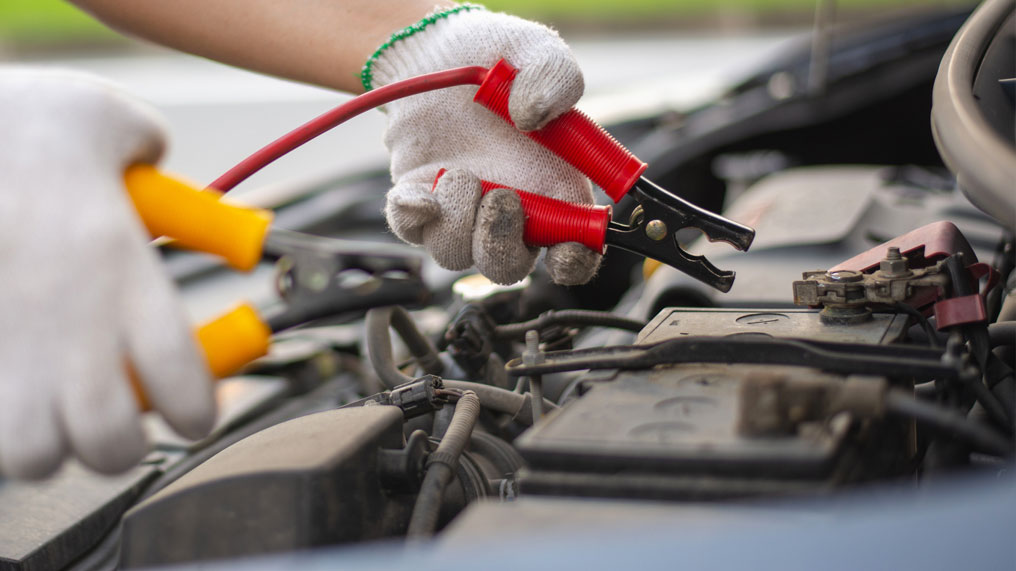There’s never a good time for your car not to start. However, being able to jump-start a car will help take the worry out of the situation, should you turn the key to find your battery has died.
We’ve created this handy guide to tell you what you should and shouldn’t do when your car won’t start. And most importantly, how to get you back up and running.
Before jump-starting a car
Don’t dive straight in. If you’re feeling stressed, you may not pay full attention to your personal safety, so it’s important to keep a cool head.
Think about your location
If your car’s parked anywhere other than a private driveway or garage, be aware of traffic and other hazards around you. Before doing anything else, turn the lights and electronics off, and remove the key from the ignition.
Then, once you’ve popped open and secured the bonnet, inspect the battery without touching it. For your safety, stick to the following rules:
-
NEVER poke around or touch the battery with anything metal. Remove any metal jewellery you might be wearing.
-
NEVER attempt to jump-start a damaged battery, or one that’s leaking or has signs of corrosion. Call an expert.
-
NEVER smoke or go anywhere near the engine with a naked flame.
-
DON’T go near the engine wearing loose clothing such as scarves, baggy sleeves or jewellery.
Before you start:
-
Check the battery for damage with your eyes only – don’t touch the battery.
-
If the battery is damaged, do not attempt to jump-start it. Call in a professional.
-
Check your owner’s manual for model-specific instructions. Some cars can’t be jump-started.
-
If you have a hybrid or EV, you can only jump-start the 12V auxiliary battery – never the high voltage system.
-
Never use a hybrid or EV as the assisting vehicle. Make sure both vehicles are turned off and in neutral (or ‘park’ if you have an automatic).
How to use jump leads
You’ll need a set of jump leads (also called jumper cables) that are in good working order and a car owner who’s willing to lend you a hand, or more precisely, the use of their car battery. It’s likely the battery will be 12 volts, but always check – it must be the same voltage as yours.
-
Park both cars within easy reach of each other.
-
Have the handbrakes on and the ignitions off.
-
Attach the red positive (+) lead to the positive terminal of the assisting car’s battery. Always start with the WORKING battery, and then connect the flat battery.
-
Now attach the other end of the red positive (+) lead to the positive terminal of the flat battery.
-
Connect the black negative (-) lead to the negative terminal of the working battery.
-
Then attach the other end of the black jump lead to an earthing point on the car with the flat battery. This will be an area of unpainted metal on the engine block or chassis of the car, well away from the battery and any fuel.
-
WARNING! Never attach the black negative (-) lead to the negative terminal on the flat battery.
-
Make sure the leads aren’t close to any moving parts.
-
Wait a few minutes and then start the engine of the working car. Let it run for a minute before starting your own car. If your car doesn’t start, wait a little longer and try again, checking that the leads aren’t getting too hot.
-
Leave the two cars running for 10 minutes or so, keeping an eye on both vehicles.
-
Turn off both engines.
-
Remove the jump leads carefully in the REVERSE order they were connected.
-
Don’t let the leads touch each other.
-
Restart your engine.
What if your car won’t start?
If the cables are fine, chances are there’s something else wrong with your car. It could be dirty or loose connections, so check that everything is in good order before trying again.
If, after several attempts, your car still doesn’t start, do not keep trying. Call a breakdown service for help.
A worn-out starter motor or faulty electrical components could be the culprit. A less likely but very serious problem could be that the engine has seized up. If this is the case, it will make a single clicking or thudding sound when you try to fire it up.
Call for roadside assistance and get your car to a garage as soon as possible.
After jump-starting your car
If you manage to get going again, you’ll need to keep driving for about 30 minutes to fully recharge the battery. That should give you enough charge to enable you to restart the engine the next time you need to.
Short trips may leave your battery undercharged, so driving around to charge it every time you have a problem it isn’t ideal. Instead, you could invest in a battery charger to keep your battery topped up. These are inexpensive and a great addition to any driver’s toolkit.
However, if the problem is bigger than just a flat battery, you’ll need to get your car checked out at a garage as soon as possible. It could be an issue with your car’s alternator.
Also, be aware that a full discharge can damage the battery’s life – another reason to take the car to a local garage for a health check.
Jump-start your car safely
Remember, jump-starting your car incorrectly can damage sensitive electronics in modern vehicles and cause a much bigger problem.
Consider using surge-protected jump leads or invest in a portable jump-starter pack for added peace of mind.
And if you’re in any doubt, don’t try to fix the problem yourself, call in the professionals.
Next time, take the stress out of a breakdown with breakdown cover.




